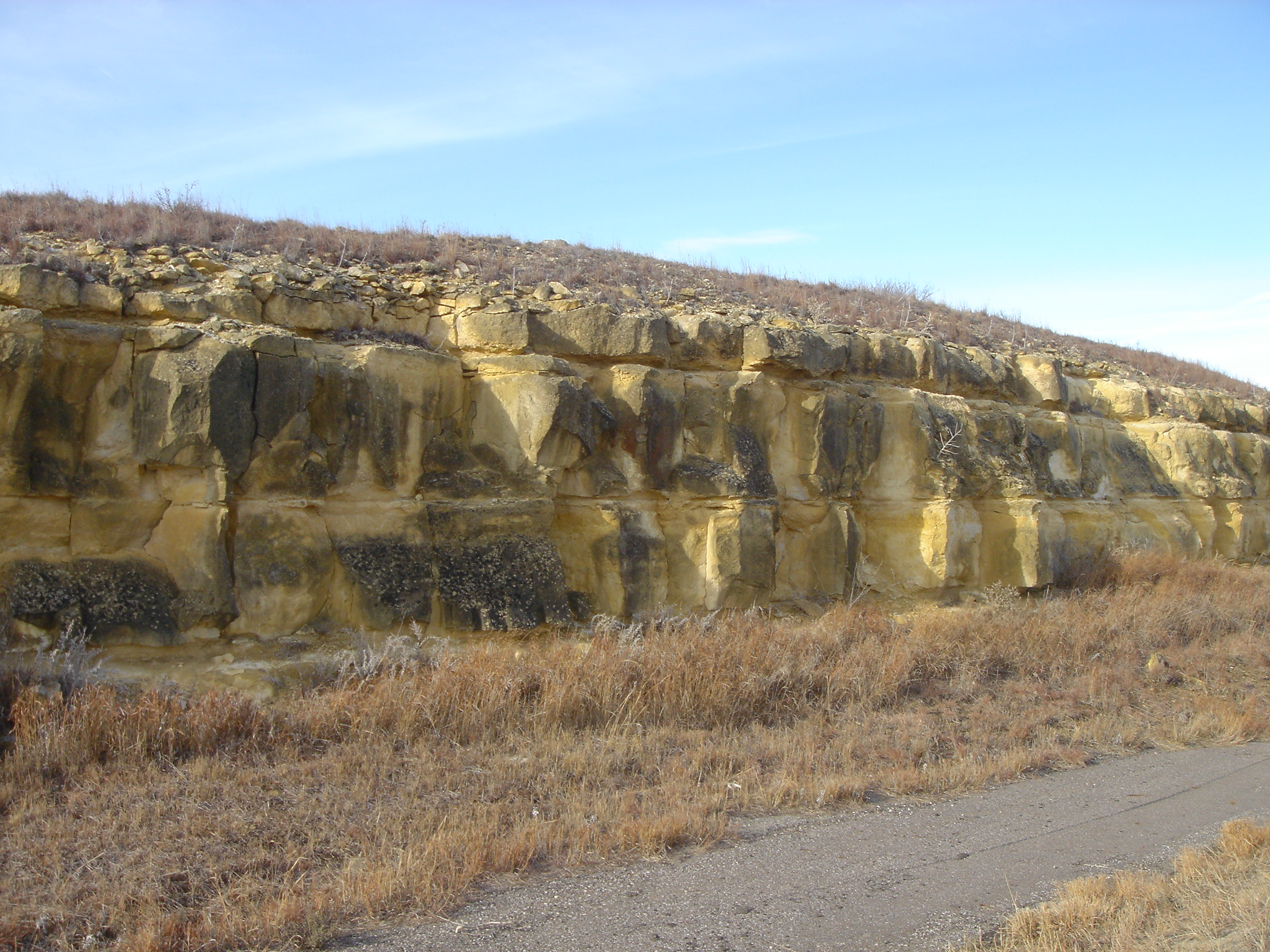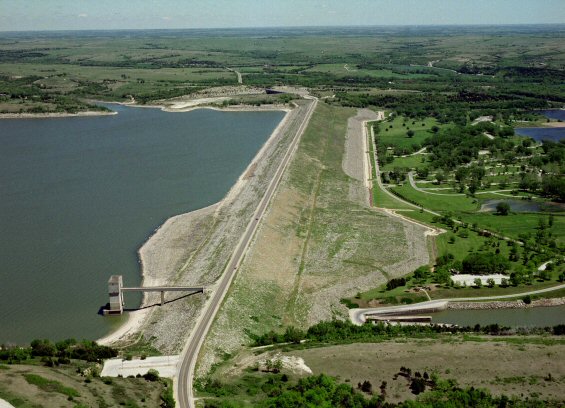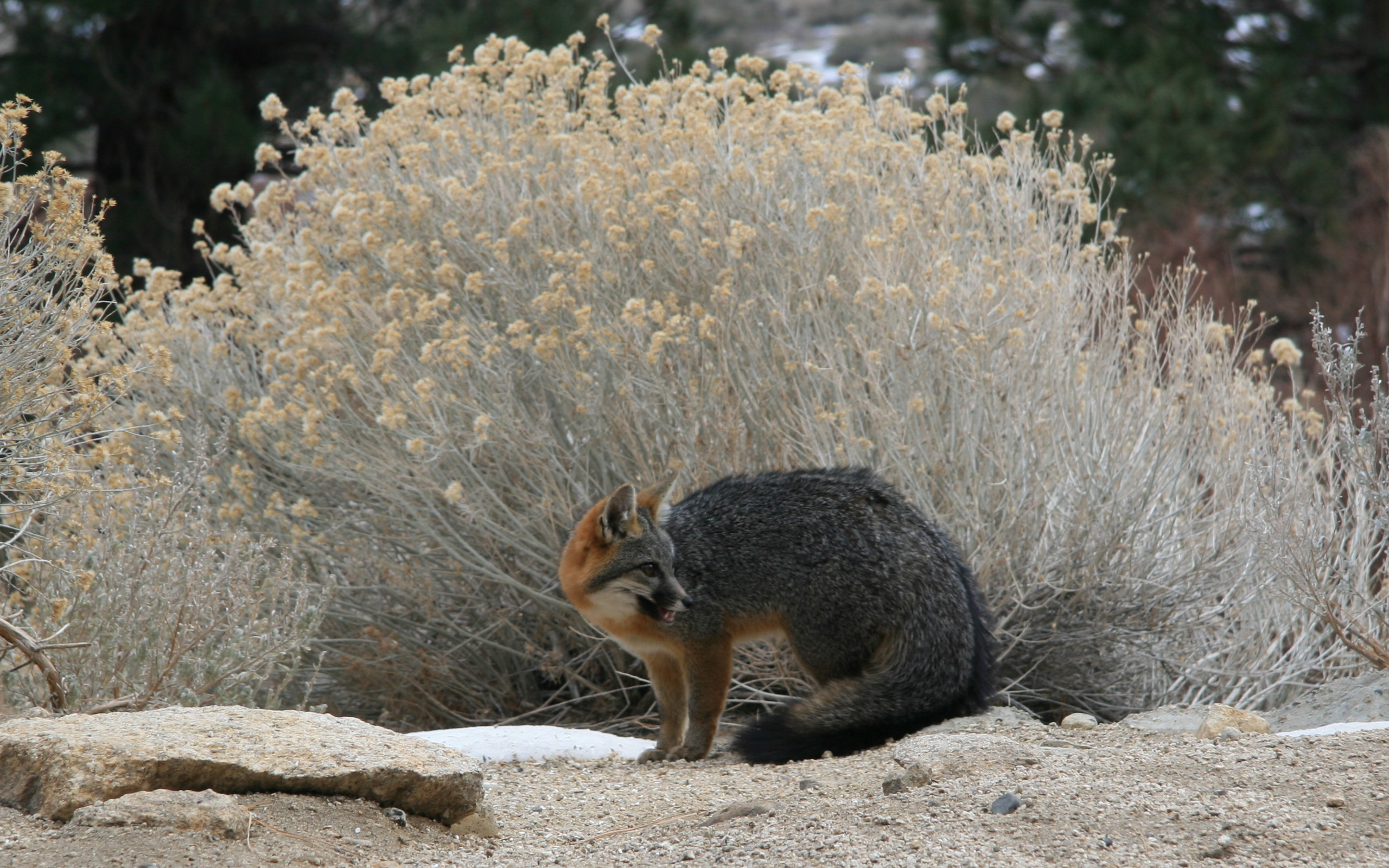|
Elk City State Park
Elk City State Park is a state park in Montgomery County, Kansas, United States, located west of Independence. The park is adjacent to the Elk City Reservoir and the Elk City Wildlife Area. The reservoir offers fishing opportunities for channel catfish, white bass, crappie, flathead catfish, largemouth bass and saugeye. The Wildlife Area offers a chance to view white-tailed deer, wild turkey, bobwhite quail, cottontail, gray squirrel, prairie chicken, beaver, raccoon, bobcat, coyote, gray fox, opossum, mink and muskrat. A nationally recognized trails system allows visitors to take in a variety of flora and fauna. The Green Thumb Nature Trail at the Timber Road campground is a one-mile loop with a panoramic vista of the lake. The nearby Table Mound Hiking Trail runs north along the east side of the lake to the scenic overlook at the dam. At the overlook is the 2/3-mile Post Oak Nature Trail. There is also a paved and handicapped accessible South Squaw Multipurpos ... [...More Info...] [...Related Items...] OR: [Wikipedia] [Google] [Baidu] |
List Of Kansas State Parks
List of state parks in the U.S. state of Kansas operated by the Kansas Department of Wildlife and Parks: See also *List of U.S. national parks *Big Basin Prairie Preserve External linksKansas Department of Wildlife and Parks State Park Website {{Kansas, expanded State parks of Kansas, Lists of state parks of the United States, Kansas state parks ... [...More Info...] [...Related Items...] OR: [Wikipedia] [Google] [Baidu] |
Montgomery County, Kansas
Montgomery County (county code MG) is a County (United States), county located in Southeast Kansas. As of the 2020 United States Census, 2020 census, the county population was 31,486. Its county seat is Independence, Kansas, Independence, and its most populous city is Coffeyville, Kansas, Coffeyville. History Early history For many millennia, the Great Plains of North America was inhabited by nomadic Native Americans in the United States, Native Americans. From the 16th century to 18th century, the Kingdom of France claimed ownership of large parts of North America. In 1762, after the French and Indian War, France secretly ceded New France to Spain, per the Treaty of Fontainebleau (1762), Treaty of Fontainebleau. 19th century In 1802, Spain returned most of the land to France, but keeping title to about 7,500 square miles. In 1803, most of the land for History of Kansas, modern day Kansas was acquired by the United States from France as part of the 828,000 square mile Louis ... [...More Info...] [...Related Items...] OR: [Wikipedia] [Google] [Baidu] |
Prairie Chicken
''Tympanuchus'' is a small genus of Aves, birds in the grouse family. They are commonly referred to as prairie chickens. Taxonomy The genus ''Tympanuchus'' was introduced in 1841 by the German zoologist C. L. Gloger, Constantin Wilhelm Lambert Gloger for the greater prairie chicken. The name combines the Ancient Greek ''tumpanon'' meaning "kettle-drum" with ''ēkheō'' meaning "to sound". The genus contains three species: All three are among the smaller grouse, from 40 to 43 cm (16 to 17 in) in length. They are found in North America in different types of prairie. In courtship display on Lek (mating arena), leks, males make hooting sounds and dance with the head extended straight forward, the tail up, and colorful neck sacks inflated (shown in the photograph at upper right). ''Tympanuchus'' comes from Ancient Greek roots and means "holding a drum"; it refers to the Biological membrane, membranous neck sacks and the drum-like call of the greater prairie chicken. The tw ... [...More Info...] [...Related Items...] OR: [Wikipedia] [Google] [Baidu] |
List Of Lakes, Reservoirs, And Dams In Kansas
This is a listing of lakes, reservoirs, and dams located in the State of Kansas. Lakes and reservoirs by size The shorelines of Kansas Lakes are mostly in government ownership and open to the public for hunting, fishing, camping, and hiking. Large areas of public land surround most of the lakes. Sources: Army Corps of Engineers, Bureau of Reclamation, Kansas State Parks. Copan, Hulah, and Kaw lakes extend into Kansas but are mostly in Oklahoma. Natural lakes * Cheyenne Bottoms of wetland and marsh in lowland"Ramsur areas" http://www.whsrn.org/site-profile/cheyenne-bottoms, accessed 20 Sep 2012 * Lake Inman * Lake View Lake * Quivira National Wildlife Refuge of wetland and marsh in refuge Man-made lakes Lakes managed by the U.S. Army Corps of Engineers * Big Hill Lake * Clinton Lake * Council Grove Lake * El Dorado Lake * Elk City Lake * Fall River Lake * Hillsdale Lake * John Redmond Reservoir * Kanopolis Lake * Marion Reservoir * Melvern Lake * Milford Lake ... [...More Info...] [...Related Items...] OR: [Wikipedia] [Google] [Baidu] |
Elk River (Kansas)
The Elk River is a tributary of the Verdigris River in southeastern Kansas in the United States. Via the Verdigris and Arkansas rivers, it is part of the Mississippi River watershed. Description and course The Elk River is formed by a collection of intermittent streams in southwestern Greenwood County, and flows for about U.S. Geological Survey. National Hydrography Dataset high-resolution flowline dataThe National Map accessed May 31, 2011 generally east-southeast through Butler, Elk, and Montgomery counties, past the towns of Elk Falls, Longton and Elk City. It joins the Verdigris River at the northern edge of the city of Independence. Between Elk City and Independence, a U.S. Army Corps of Engineers dam causes the river to form Elk City Lake. A state park and federal lands along the lake offer recreation, including three National Recreation Trails. The Elk River Archeological District is a area in Elk and Montgomery counties, presumably in the Elk River wate ... [...More Info...] [...Related Items...] OR: [Wikipedia] [Google] [Baidu] |
Fauna
Fauna is all of the animal life present in a particular region or time. The corresponding term for plants is ''flora'', and for fungi, it is '' funga''. Flora, fauna, funga and other forms of life are collectively referred to as '' biota''. Zoologists and paleontologists use ''fauna'' to refer to a typical collection of animals found in a specific time or place, e.g. the "Sonoran Desert fauna" or the "Burgess Shale fauna". Paleontologists sometimes refer to a sequence of faunal stages, which is a series of rocks all containing similar fossils. The study of animals of a particular region is called faunistics. Etymology ''Fauna'' comes from the name Fauna, a Roman goddess of earth and fertility, the Roman god Faunus, and the related forest spirits called Fauns. All three words are cognates of the name of the Greek god Pan, and ''panis'' is the Greek equivalent of fauna. ''Fauna'' is also the word for a book that catalogues the animals in such a manner. The term was first used b ... [...More Info...] [...Related Items...] OR: [Wikipedia] [Google] [Baidu] |
Flora
Flora is all the plant life present in a particular region or time, generally the naturally occurring (indigenous) native plants. Sometimes bacteria and fungi are also referred to as flora, as in the terms '' gut flora'' or '' skin flora''. Etymology The word "flora" comes from the Latin name of Flora, the goddess of plants, flowers, and fertility in Roman mythology. The technical term "flora" is then derived from a metonymy of this goddess at the end of the sixteenth century. It was first used in poetry to denote the natural vegetation of an area, but soon also assumed the meaning of a work cataloguing such vegetation. Moreover, "Flora" was used to refer to the flowers of an artificial garden in the seventeenth century. The distinction between vegetation (the general appearance of a community) and flora (the taxonomic composition of a community) was first made by Jules Thurmann (1849). Prior to this, the two terms were used indiscriminately.Thurmann, J. (1849). ''Essai de ... [...More Info...] [...Related Items...] OR: [Wikipedia] [Google] [Baidu] |
Muskrat
The muskrat (''Ondatra zibethicus'') is a medium-sized semiaquatic rodent native to North America and an introduced species in parts of Europe, Asia, and South America. The muskrat is found in wetlands over a wide range of climates and habitats. It has important effects on the ecology of wetlands, and is a resource of food and fur for humans. Adult muskrats weigh , with a body length of . They are covered with short, thick fur of medium to dark brown color. Their long tails, covered with scales rather than hair, are their main means of propulsion. Muskrats spend most of their time in the water and can swim under water for 12 to 17 minutes. They live in families, consisting of a male and female pair and their young. To protect themselves from the cold and from predators, they build nests that are often burrowed into the bank with an underwater entrance. Muskrats feed mostly on cattail and other aquatic vegetation but also eat small animals. ''Ondatra zibethicus'' is the only s ... [...More Info...] [...Related Items...] OR: [Wikipedia] [Google] [Baidu] |
Mink
Mink are dark-colored, semiaquatic, carnivorous mammals of the genera ''Neogale'' and '' Mustela'' and part of the family Mustelidae, which also includes weasels, otters, and ferrets. There are two extant species referred to as "mink": the American mink and the European mink. The extinct sea mink was related to the American mink but was much larger. The American mink's fur has been highly prized for use in clothing. Their treatment on fur farms has been a focus of animal rights and animal welfare activism. American mink have established populations in Europe (including Great Britain and Denmark) and South America. Some people believe this happened after the animals were released from mink farms by animal rights activists, or otherwise escaped from captivity. In the UK, under the Wildlife and Countryside Act 1981, it is illegal to release mink into the wild. In some countries, any live mink caught in traps must be humanely killed. American mink are believed by some to have c ... [...More Info...] [...Related Items...] OR: [Wikipedia] [Google] [Baidu] |
Opossum
Opossums () are members of the marsupial order Didelphimorphia () endemic to the Americas. The largest order of marsupials in the Western Hemisphere, it comprises 93 species in 18 genera. Opossums originated in South America and entered North America in the Great American Interchange following the connection of North and South America. The Virginia opossum is the only species found in the United States and Canada. It is often simply referred to as an opossum, and in North America it is commonly referred to as a possum (; sometimes rendered as ''possum'' in written form to indicate the dropped "o"). Possums should not be confused with the Australasian arboreal marsupials of suborder Phalangeriformes that are also called possums because of their resemblance to the Didelphimorphia. The opossum is typically a nonaggressive animal. Etymology The word ''opossum'' is borrowed from the Powhatan language and was first recorded between 1607 and 1611 by John Smith (as ''opassom'') ... [...More Info...] [...Related Items...] OR: [Wikipedia] [Google] [Baidu] |
Gray Fox
The gray fox (''Urocyon cinereoargenteus''), or grey fox, is an omnivorous mammal of the family Canidae, widespread throughout North America and Central America. This species and its only congener, the diminutive island fox (''Urocyon littoralis'') of the California Channel Islands, are the only living members of the genus ''Urocyon'', which is considered to be genetically basal to all other living canids. Its species name ''cinereoargenteus'' means " ashen silver". It was once the most common fox in the eastern United States, and though still found there, human advancement and deforestation allowed the red fox to become the predominant fox-like canid. Despite this post-colonial competition, the gray fox has been able to thrive in urban and suburban environments, one of the best examples being southern Florida. The Pacific States and Great Lakes region still have the gray fox as their prevalent fox. Etymology The genus ''Urocyon'' comes from the Latin 'uro' meaning tail, an ... [...More Info...] [...Related Items...] OR: [Wikipedia] [Google] [Baidu] |
Coyote
The coyote (''Canis latrans'') is a species of canis, canine native to North America. It is smaller than its close relative, the wolf, and slightly smaller than the closely related eastern wolf and red wolf. It fills much of the same ecological niche as the golden jackal does in Eurasia. The coyote is larger and more predatory and was once referred to as the American jackal by a behavioral ecologist. Other historical names for the species include the prairie wolf and the brush wolf. The coyote is listed as Least Concern, least concern by the International Union for Conservation of Nature, due to its wide distribution and abundance throughout North America. The species is versatile, able to adapt to and expand into environments modified by humans. It is enlarging its range by moving into urban areas in the eastern U.S. and Canada. The coyote was sighted in eastern Panama (across the Panama Canal from their home range) for the first time in 2013. The coyote has 19 recognized sub ... [...More Info...] [...Related Items...] OR: [Wikipedia] [Google] [Baidu] |

_(cropped).jpg)







